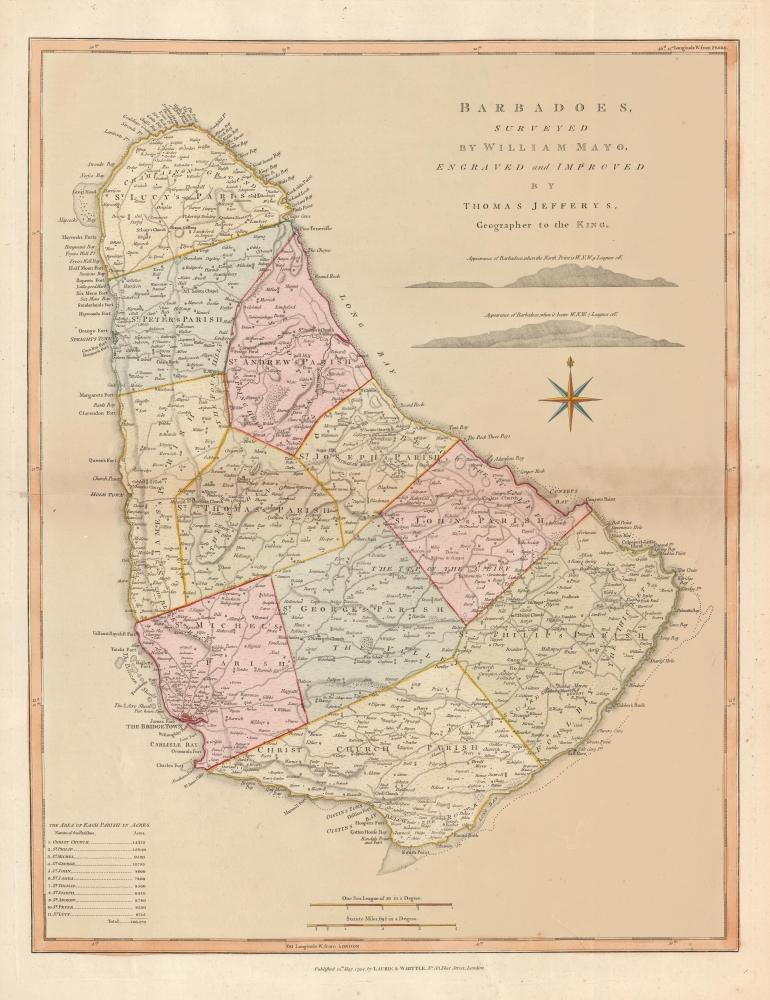1794 Jefferys Map of Barbados
Barbadoes-jefferys-1794
Title
1794 (dated) 26 x 20 in (66.04 x 50.8 cm) 1 : 65000
Description
A Closer Look
This map follows the William Mayo survey of 1717-21, the first systematic survey of Barbados, which formally laid out the parishes and identified some 963 plantations, some of which had mills. Roads throughout illustrate the island's well-developed transport network. Along the coast, several important forts are identified, underscoring the significant role Barbados played in maintaining British hegemony in the West Indies. Profile diagrams under the title illustrate Barbados from various points at sea. A table in the lower left breaks out population by parish, with a total population of 106,470, most of which would have been enslaved plantation workers.Britain's Richest Colony
In the late 18th century, Barbados was a British colony and a major hub of the transatlantic sugar trade. The island's economy thrived on sugar production, making it one of the wealthiest colonies in the British Empire. The plantation elite, known as the 'plantocracy,' dominated social, political, and economic life. Bridgetown, the capital, was a bustling port where goods, including sugar, rum, and molasses, were exported. During this period, Barbados also played a key role in British naval strategy in the Caribbean, with its location being critical to regional trade and defense.Publication History and Census
This map was compiled by Thomas Jefferys before his death in 1771 but was not published until 1775 by Robert Sayer for The West-India Atlas. The atlas was taken over in 1794, after Sayer's death, by Laurie and Whittle, who issued this edition. We are aware of editions in 1775, 1787, 1794 (this example), 1796, 1807, and 1818. Most editions are uncolored, so it is particularly delightful to find an example like this with fine original color.CartographerS
Thomas Jefferys (1695 - November 20, 1771) was one of the most prominent and prolific map publishers and engravers of his day. Jefferys was born in Birmingham and was apprenticed to the engraver Emmanuel Bowen in 1735. Later, in the 1740s he engraved several maps for the popular periodical Gentleman's Magazine. Around 1740 Jefferys was finally able to go into business for himself and in 1746 received an appointment as 'Geographer to Fredrick, Prince of Wales,' which shortly after translated to the position of 'Royal Cartographer to King George III.' Jefferys initially specialized in compiling and re-engraving the works of earlier cartographers into more coherent cartographic wholes. Later, while not salaried position, Jefferys' appointment as 'Royal Cartographer' guaranteed preferential access to the most up to date cartographic material available, allowing him to produce new and updated charts of exceptional accuracy. He his best known for his maps of the Americas, particularly the posthumously published 1775 American Atlas, which included some of the finest and most important late colonial era maps of America ever made. Despite his prolific publishing history, royal appointments, and international publishing fame, Jefferys lived most of his life in dire economic straits. He was bailed out of bankruptcy by Robert Sayer during the production of the American Atlas. In the end, Jefferys died suddenly with very little to his name. Nonetheless, his cartographic legacy survived, and even after his death in 1771, many of his important maps continued to be published and republished by Sayer and Bennet, Conrad Lotter, Georges Louis Le Rouge, Laurie and Whittle, and others. Many attribute some of Jefferys best maps to the colorful and criminally inclined Irish cartographic genius Braddock Mead (John Green, c. 1688 - 1757), who is considered the 'secret behind Jefferys.' Jefferys was succeeded by his son, also Thomas, who had little success as a cartographer and eventually partnered with, then sold his stock and plates to William Faden - Jefferys' true heir. More by this mapmaker...
Laurie and Whittle (fl. 1794 - 1858) were London, England, based map and atlas publishers active in the late 18th and early 19th century. Generally considered to be the successors to the Robert Sayer firm, Laurie and Whittle was founded by Robert Laurie (c. 1755 - 1836) and James Whittle (1757-1818). Robert Laurie was a skilled mezzotint engraver and is known to have worked with Robert Sayer on numerous projects. James Whittle was a well-known London socialite and print seller whose Fleet Street shop was a popular haunt for intellectual luminaries. The partnership began taking over the general management of Sayer's firm around 1787; however, they did not alter the Sayer imprint until after Sayer's death in 1794. Apparently Laurie did most of the work in managing the firm and hence his name appeared first in the "Laurie and Whittle" imprint. Together Laurie and Whittle published numerous maps and atlases, often bringing in other important cartographers of the day, including Kitchin, Faden, Jefferys and others to update and modify their existing Sayer plates. Robert Laurie retired in 1812, leaving the day to day management of the firm to his son, Richard Holmes Laurie (1777 - 1858). Under R. H. Laurie and James Whittle, the firm renamed itself "Whittle and Laurie". Whittle himself died six years later in 1818, and thereafter the firm continued under the imprint of "R. H. Laurie". After R. H. Laurie's death the publishing house and its printing stock came under control of Alexander George Findlay, who had long been associated with Laurie and Whittle. Since, Laurie and Whittle has passed through numerous permeations, with part of the firm still extant as an English publisher of maritime or nautical charts, 'Imray, Laurie, Norie and Wilson Ltd.' The firm remains the oldest surviving chart publisher in Europe. Learn More...

